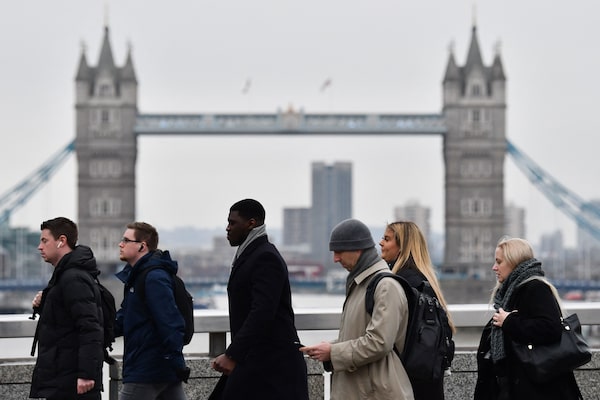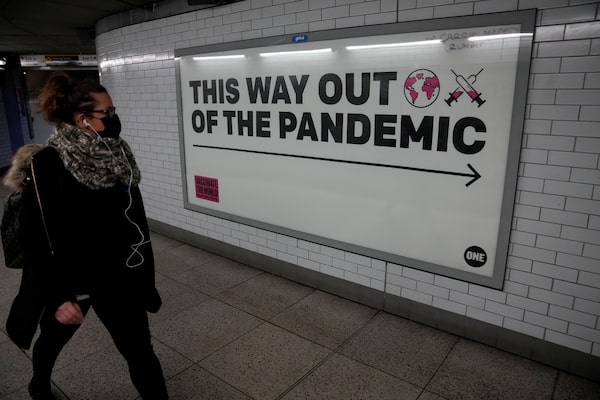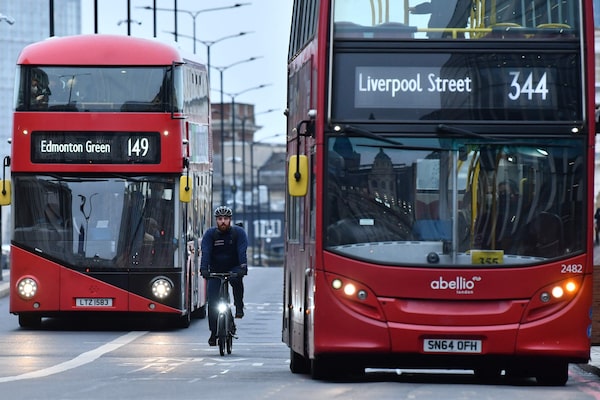
London's Tower Bridge looms in the background as unmasked Britons cross London Bridge during morning rush hour on Jan. 27, England's first day with no mandatory COVID-19 restrictions.JUSTIN TALLIS/AFP via Getty Images
The pandemic is still raging across much of the world, but in Britain, COVID-19 restrictions are becoming a thing of the past.
Thursday saw the end of almost all mandatory measures in England. Masks are no longer required anywhere, and vaccine passports have been dropped – although they were only compulsory in nightclubs and at large events such as soccer games. There is also no longer any work-from-home guidance.
The government is also removing the limit on the number of visitors allowed in nursing homes in England next week, and all testing requirements for fully vaccinated travellers will expire Feb. 11.
Just about the only measure left in place, self-isolation for up to 10 days after a positive COVID-19 test –could also be scrapped before the end of March.
Governments in Scotland, Wales and Northern Ireland have also eased many of their restrictions, although face coverings continue to be required in most public places in those regions.

A masked commuter passes a poster from the One NGO in London's subway on Jan. 27.Matt Dunham/The Associated Press
While many other countries, including Canada, have also begun to drop some COVID-19 measures, few have gone as far as Britain. And the British government has made it clear that it doesn’t want the country held back by the virus any longer.
“We’ve got to find a way to live with it in the same way we live with flu,” Health Secretary Sajid Javid told the House of Commons Health and Social Affairs Committee this week.
“It’s about understanding that we do now have defences which we didn’t have before, and just as flu doesn’t stop society, and stop life, we mustn’t let COVID do that any more.”
It’s a risky move that will be watched closely by governments around the world, especially given the uncertainty surrounding the Omicron variant.
While the number of new daily COVID-19 cases in the U.K. has fallen sharply since reaching a high of 218,000 on Jan. 4, infections have been increasing in recent days. On Wednesday, health officials reported 102,292 new cases, up from 94,326 the previous day and 88,447 on Monday.
Hospital admissions have fallen from about 2,600 a day at the start of January to 1,300 Wednesday. Some health experts had forecast that admissions would rise to more than 3,000 a day because of Omicron, but so far that hasn’t happened.
Nonetheless, researchers at Imperial College who have been tracking infections in England since the start of the pandemic say hospitals could still face increased pressure.
An Imperial study known as the Real-time Assessment of Community Transmission-1, or REACT-1, has been monitoring the prevalence of the virus since May, 2020, through regular random testing of people across England. Every month the researchers receive swab samples from about 100,000 participants.
The researchers said the results for January, which were released Wednesday, “saw the highest prevalence ever observed in the REACT-1 study, some threefold higher than at the peak of the second wave in January, 2021.” They added that although cases had begun to drop among adults, infections continued to rise among elementary school children, where the prevalence of the virus remained higher than in any other age group.
“There is a risk of transmission from the children to adults,” said Paul Elliott, an epidemiologist at Imperial who leads the REACT-1 program. Dr. Elliott added in a conference call with journalists that “the rapid increase in Omicron infections may continue to put pressure on health services.”
He also said it wasn’t clear whether infection rates would fall further or remain at the current elevated level for a while. That happened last summer when the Delta variant swept across the U.K. After an initial increase in cases, the daily infection rate dropped and then held steady at between 30,000 and 50,000 cases for months until Omicron hit in November. “Are we going to see the same thing again at a new set point for Omicron? We just don’t know,” Dr. Elliott said. “The trends are a bit uncertain right now.”

A commuter bikes through central London on Jan. 27.JUSTIN TALLIS/AFP via Getty Images
Some health experts were apprehensive about the lifting of restrictions. “We may be moving into a phase of the pandemic where the population has a high level of immunity to severe disease, arising from natural infection and vaccination,” said Dame Anne Johnson, president of the Academy of Medical Sciences. “But we must recognize that there is still great uncertainty. Hospitals are still under immense pressure, even with a reduction of COVID-19 admissions, and infection rates remain very high.”
But Simon Williams, a senior lecturer in people and organization at Swansea University, said removing restrictions was in line with public opinion. “Many people were feeling that Omicron is ‘another variant’ and that we should ‘start living’ with COVID,” Dr. Williams said. “And so, there is a general feeling amongst many in the public that mandated measures shouldn’t be in place longer than necessary.”
Some stores in England, including supermarket chain Sainsbury’s, have said they will ask customers and staff to keep wearing masks. And Mayor Sadiq Khan has said masks will still be required on the London Underground.
But most businesses welcomed the end of mandatory measures. “Businesses will be hopeful that we are finally starting to turn the corner on COVID-19,” said Matthew Fell, the chief policy director at the Confederation of British Industry. “There’s a vital need now for greater consistency in how we live with the virus in the longer term.”
COVID-19: More from The Globe and Mail
The Decibel
How are scientists tracking the mutations of COVID-19 variants like Omicron to learn what they might do to populations next? Globe science reporter Ivan Semeniuk explains. Subscribe for more episodes.
Explainers
Omicron symptoms mirror the flu and cold. What should I do if I feel sick?
How many COVID-19 cases are there in Canada and worldwide? The latest maps and charts
Health columnist André Picard
‘I’m done with COVID’ is easier said than done
There’s nothing ‘incidental’ about hospital patients with COVID-19
Quebec’s tax on the unvaccinated is punitive and unhelpful
 Paul Waldie
Paul Waldie